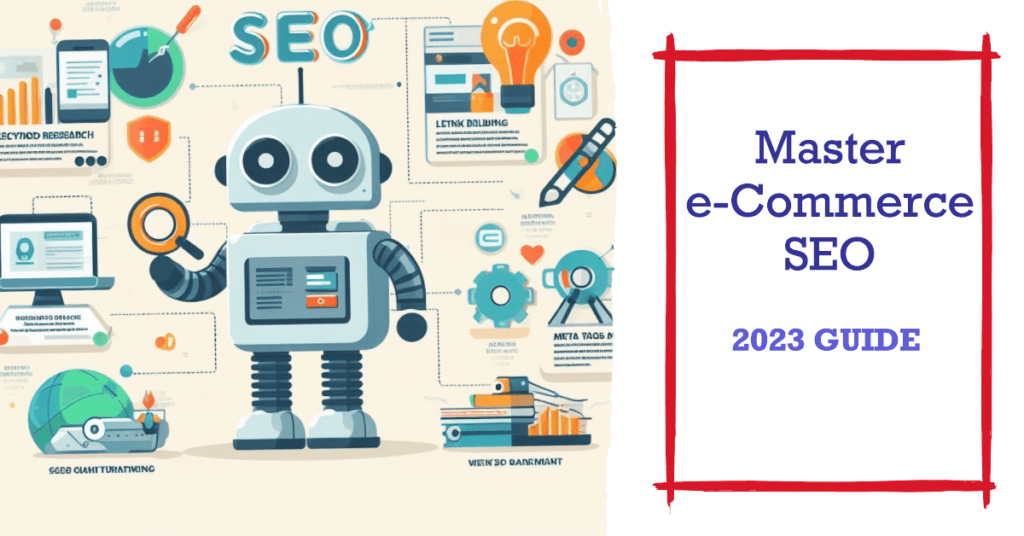Master E-Commerce SEO in 2023

Introduction
In the fast-paced world of e-commerce, effectively harnessing the power of Search Engine Optimization (SEO) can be the difference between standing out among the competition and struggling to gain visibility. SEO offers a reliable pathway to enhance your online store’s visibility in search engine results, driving more potential customers to your website and, ultimately, increasing sales. In this comprehensive guide, we will explore the key strategies and techniques required to master e-commerce SEO and propel your online store to new heights.
Why SEO Matters in E-commerce
Before diving into the nitty-gritty of e-commerce SEO, it’s essential to understand why it’s so crucial for your online store’s success. With millions of online stores vying for attention, here’s why SEO matters:
1: Keyword Research and Analysis
Effective e-commerce SEO begins with a solid foundation of keyword research. Discovering the right keywords and phrases that your target audience uses when searching for products like yours is the cornerstone of your SEO strategy. Here’s how to master this essential aspect:
- Identify High-Value Keywords
- Utilize keyword research tools like Google Keyword Planner, SEMrush, and Ahrefs to identify high-value keywords relevant to your products.
- Pay attention to search volume, competition, and keyword relevance.
- Don’t Overlook Long-Tail Keywords
- Long-tail keywords can be less competitive and highly targeted.
- Incorporate long-tail keywords into your content for specific product pages.
- Competitor Analysis
- Analyze your competitors’ keyword strategies to discover opportunities and weaknesses in your niche.
- Identify keywords that your competitors are ranking well for and consider optimizing your content for those as well.
2: On-Page Optimization
On-page SEO is the art of optimizing individual pages on your e-commerce website to make them more search engine-friendly. A well-optimized page can significantly impact your search rankings:
- Crafting Effective Title Tags
-
- Create descriptive and compelling title tags that include relevant keywords and provide a clear idea of what the page is about.
- Aim for a unique title tag for each product or category page.
- Meta Descriptions That Drive Clicks
-
- Craft concise and enticing meta descriptions that encourage users to click on your link.
- Include a call-to-action and highlight the value of the page’s content.
- Unique and Engaging Product Descriptions
-
- Write unique, detailed, and engaging product descriptions that not only include keywords but also provide valuable information to customers.
- Highlight the benefits, features, and unique selling points of your products.
- Utilizing Header Tags
-
- Use header tags (H1, H2, H3, etc.) to structure your content, making it more understandable to both search engines and users.
- Use H1 tags for page titles, H2 and H3 tags for subheadings, and structure your content logically.
3: Mobile Optimization
The shift towards mobile shopping continues to grow. Google rewards mobile-responsive websites with higher rankings. Ensure your online store is mobile-friendly:
- Responsive Design
-
- Opt for a responsive web design to ensure your site adapts seamlessly to various screen sizes and devices.
- Test your site on different devices to ensure it renders correctly.
- Mobile Usability Testing
-
- Thoroughly test your website’s mobile usability and make the necessary adjustments to improve the user experience for mobile shoppers.
- Optimize images for mobile, streamline navigation, and ensure buttons and links are easily clickable on small screens.
4: Site Speed
Site speed is a crucial factor for both SEO and user experience. Slow-loading pages can lead to higher bounce rates and lower search engine rankings:
- Image Optimization
-
- Optimize images for the web to reduce loading times without sacrificing quality.
- Use image compression tools and specify image dimensions in your HTML to improve load times.
- Content Delivery Networks (CDNs)
-
- Utilize CDNs to deliver content from servers geographically closer to your website visitors.
- CDNs reduce latency and speed up content delivery.
- Browser Caching
-
- Leverage browser caching to store frequently used resources in your visitor’s browser.
- Set appropriate cache headers to enable the browser to store and reuse certain resources, reducing the need to reload them.
5: High-Quality Content Creation
Creating high-quality, relevant, and valuable content can significantly boost your e-commerce SEO efforts:
- Starting a Blog or Resource Section
-
- Create a blog or resource section on your website to provide informative content related to your products or industry.
- Write comprehensive, well-researched articles that address common questions and pain points of your target audience.
- Attracting Natural Backlinks
-
- High-quality content naturally attracts backlinks, which can improve your site’s authority and rankings.
- Promote your content through social media, email marketing, and outreach to industry influencers to increase its visibility.
6: User Experience
Search engines consider user experience when ranking websites. Ensure that your e-commerce site offers a seamless and engaging experience:
- Clear Calls-to-Action
-
- Use clear and compelling calls-to-action (CTAs) to guide users to take desired actions.
- Ensure that CTAs are prominently placed on product pages, checkout pages, and other key locations.
- Simple Navigation
-
- Implement easy-to-navigate menus and a user-friendly checkout process.
- Streamline the purchasing process, minimize steps, and provide clear progress indicators for users.
7: Website Security
Website security is a factor search engines value, and it builds trust with your customers:
- Implementing SSL Encryption
-
- Secure your website with SSL encryption to protect user data and earn trust from both customers and search engines.
- Ensure all sensitive data, including payment information, is transmitted securely.
8: Schema Markup
Schema markup helps search engines understand your website’s content better, leading to rich snippets in search results:
- Leveraging Schema Markup
-
- Implement schema markup for product reviews, prices, and availability to enhance your search engine visibility.
- Follow the schema.org guidelines and use structured data markup for your products.
9: Backlinks and Link Building
Earning high-quality backlinks from reputable websites is a valuable SEO strategy for e-commerce:
- Developing a Link-Building Strategy
-
- Create a comprehensive link-building plan that includes guest posting, influencer partnerships, and active participation in industry-related forums and communities.
- Seek out relevant and authoritative websites for guest posting and collaboration opportunities.
Conclusion
Mastering e-commerce SEO is an ongoing journey that demands dedication and strategic execution. By implementing the strategies detailed in this guide, you can significantly enhance your online store’s visibility, attract organic traffic, and ultimately drive higher sales. Remember that SEO is a dynamic field, so stay informed about the latest trends and best practices to maintain a competitive edge in the ever-evolving e-commerce landscape.
Related Posts

AI Chat Open Assistant Chatbot

The Rise of Google’s Artificial Intelligence: How AI is Changing the Technology Landscape

Rank #1 on Google Search by optimizing these 3 Ad aspects
About Author
Anish
Digital Marketer, passionate about travel and adventure sports. Follow on Facebook Profile - https://www.facebook.com/anish.sudarsan/ & Instagram Profile - https://www.instagram.com/anishsudarsan/